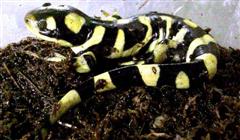Salamander - Barred Tiger
Scientific Name: Ambystoma tigrinum mavortium
Wed, 2nd July, 2025 - 6:01 pm GMT
Sponsor Ads:

Alternative Name
Scientific Name: Ambystoma tigrinum mavortiumBasic Info
The largest land-dwelling salamander in existence, the Barred Tiger Salamander averages between 6 and 9 inches. They have dark skin, which has bright yellow or olive green spots or bars on the back and sides. The most common pattern is yellow bars, giving it the tiger-like appearance. They have between eleven and fourteen costal grooves on their bodies. Their front feet have four toes and the back feet have five. They appear to always be grinning. The larval stage looks much like the adult, but with six feathery gills that are external and extend from the neck.
Health
Barred Tiger Salamanders are easy to care for. They will eat salamander bites, reptile sticks, earthworms, crickets and small feeder fish. Because they eat fish, they may attack and kill any small fish that are housed with in their tank. As a general rule of thumb they should not be kept with smaller animals that could fit in their mouths as they will usually see these as food sources. They seem to do well in an enclosure that has both land and water environments. Breeding The Barred Tiger Salamander can breed both in the larval stage and as mature adults. They only breed after lots of rain, between December and March. Many Barred Tiger Salamanders never breed because the conditions are not favorable. The female lays as many as 1000 eggs in several clutches that are attached to sticks and weeds in or near water. They hatch after three to five weeks, depending on the temperature of the water.Habitat
They are most common in swamps, marshes, wetlands, or roadside ditches where fish do not live.Behavior
While some aquatic salamanders, such as the Hellbender, grow quite large, the Barred Tiger Salamander is the largest terrestrial salamander in the world. They are very difficult to find in the wild, although they are quite common both in the wild and in captivity. In fact they are the most popular of all the Tiger Salamander subspecies in captivity. The Barred Tiger Salamander feeds primarily on insects, earthworms, small rodents, and other amphibians. They are nocturnal and live primarily in underground caverns that they dig or in dense vegetation surrounding water, which enables them to avoid predation by snakes, turtles, fish, and herons that enjoy feeding on the Barred Tiger Salamander. Their living environment also makes them quite difficult to find in the wild, although they are common in a wide range, from central Nebraska to northern Mexico. The Barred Tiger Salamander is capable of neoteny, meaning that if the living conditions on the land surrounding the water in which they develop is inhospitable, they will not metamorphose. They will instead retain the gills and tail fin, which allow them to live underwater. When conditions improve, they can transform immediately. They usually breed in winter and can breed both in the larval stage and as adults.Origin
North AmericaHistory
The Barred Tiger Salamander, like all salamanders, is not vocal. They are very common in Kansas and the Great Plains area, although their nocturnal lifestyle makes them difficult to find in the wild. They prefer to live in areas that only fill with water during wet weather so that there is no fish population. While the larva are often mistaken for mudpuppies or waterdogs, they are not the same species. The Barred Tiger Salamander can live up to twenty years in favorable conditions.Common Foods
feeds primarily on insects, earthworms, small rodents, small animals.Sponsor Ads:
Laws of Programming: #5 - A hardware failure will cause system software to crash, and the customer engineer will blame the programmer
Salamander - Barred Tiger
Coded by: BGID® | ALL RIGHTS RESERVED Copyright © 2000-2025
Disclaimer | Privacy | Report Errors / Contact | Credits

 Preparing For China. China is growing their military. China Military Technology - can it keep up with the US?
Preparing For China. China is growing their military. China Military Technology - can it keep up with the US?  versus
versus 

 versus
versus 
 This Thread is about the North Korean Military itself - the kind of army, navy, and air force they have.
This Thread is about the North Korean Military itself - the kind of army, navy, and air force they have. 
 versus
versus 
 versus
versus  versus
versus